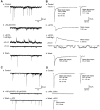Ca(2+)-permeable AMPA receptors and spontaneous presynaptic transmitter release at developing excitatory spinal synapses
- PMID: 10493753
- PMCID: PMC6783006
- DOI: 10.1523/JNEUROSCI.19-19-08528.1999
Ca(2+)-permeable AMPA receptors and spontaneous presynaptic transmitter release at developing excitatory spinal synapses
Abstract
At many mature vertebrate glutamatergic synapses, excitatory transmission strength and plasticity are regulated by AMPA and NMDA receptor (AMPA-R and NMDA-R) activation and by patterns of presynaptic transmitter release. Both receptors potentially direct neuronal differentiation by mediating postsynaptic Ca(2+) influx during early development. However, the development of synaptic receptor expression and colocalization has been examined developmentally in only a few systems, and changes in release properties at neuronal synapses have not been characterized extensively. We recorded miniature EPSCs (mEPSCs) from spinal interneurons in Xenopus embryos and larvae. In mature 5-8 d larvae, approximately 70% of mEPSCs in Mg(2+)-free saline are composed of both a fast AMPA-R-mediated component and a slower NMDA-R-mediated decay, indicating receptor colocalization at most synapses. By contrast, in 39-40 hr embryos approximately 65% of mEPSCs are exclusively fast, suggesting that these synapses initially express predominantly AMPA-R. In a physiological Mg(2+) concentration (1 mM), mEPSCs throughout development are mainly AMPA-R-mediated at negative potentials. Embryonic synaptic AMPA-R are highly Ca(2+)-permeable, mEPSC amplitude is over twofold larger than at mature synapses, and mEPSCs frequently occur in bursts consistent with asynchronous multiquantal release. AMPA-R function in this motor pathway thus appears to be independent of previous NMDA-R activation, unlike other regions of the developing nervous system, ensuring a greater reliability for embryonic excitatory transmission. Early spontaneous excitatory activity is specialized to promote AMPA-R-mediated synaptic Ca(2+) influx, which likely has significant roles in neuronal development.
Figures









Similar articles
-
Properties of miniature glutamatergic EPSCs in neurons of the locomotor regions of the developing zebrafish.J Neurophysiol. 2000 Jan;83(1):181-91. doi: 10.1152/jn.2000.83.1.181. J Neurophysiol. 2000. PMID: 10634865
-
Rapid kinetics and inward rectification of miniature EPSCs in layer I neurons of rat neocortex.J Neurophysiol. 1997 May;77(5):2416-26. doi: 10.1152/jn.1997.77.5.2416. J Neurophysiol. 1997. PMID: 9163367
-
Endogenous NMDA-receptor activation regulates glutamate release in cultured spinal neurons.J Neurophysiol. 1998 Jul;80(1):196-208. doi: 10.1152/jn.1998.80.1.196. J Neurophysiol. 1998. PMID: 9658041
-
Speaking out of turn: a role for silent synapses in pain.IUBMB Life. 1999 Sep;48(3):251-6. doi: 10.1080/713803505. IUBMB Life. 1999. PMID: 10690634 Review.
-
Induction and expression rules of synaptic plasticity in hippocampal interneurons.Neuropharmacology. 2011 Apr;60(5):720-9. doi: 10.1016/j.neuropharm.2010.12.016. Epub 2010 Dec 30. Neuropharmacology. 2011. PMID: 21195098 Free PMC article. Review.
Cited by
-
A developmental switch of AMPA receptor subunits in neocortical pyramidal neurons.J Neurosci. 2002 Apr 15;22(8):3005-15. doi: 10.1523/JNEUROSCI.22-08-03005.2002. J Neurosci. 2002. PMID: 11943803 Free PMC article.
-
Activity-dependent neurotransmitter-receptor matching at the neuromuscular junction.Proc Natl Acad Sci U S A. 2007 Jan 2;104(1):335-40. doi: 10.1073/pnas.0607450104. Epub 2006 Dec 26. Proc Natl Acad Sci U S A. 2007. PMID: 17190810 Free PMC article.
-
Ca(2+) permeable AMPA receptors switch allegiances: mechanisms and consequences.J Physiol. 2012 Jan 1;590(1):13-20. doi: 10.1113/jphysiol.2011.213926. Epub 2011 Sep 5. J Physiol. 2012. PMID: 21893602 Free PMC article. Review.
-
Cyclophilin D deficiency rescues axonal mitochondrial transport in Alzheimer's neurons.PLoS One. 2013;8(1):e54914. doi: 10.1371/journal.pone.0054914. Epub 2013 Jan 31. PLoS One. 2013. PMID: 23382999 Free PMC article.
-
Embryonically expressed GABA and glutamate drive electrical activity regulating neurotransmitter specification.J Neurosci. 2008 Apr 30;28(18):4777-84. doi: 10.1523/JNEUROSCI.4873-07.2008. J Neurosci. 2008. PMID: 18448654 Free PMC article.
References
-
- Bekkers JM, Stevens CF. NMDA and non-NMDA receptors are colocalized at individual excitatory synapses in cultured rat hippocampus. Nature. 1989;341:230–233. - PubMed
-
- Bekkers JM, Stevens CF. Quantal analysis of EPSCs recorded from small numbers of synapses in hippocampal cultures. J. Neurophysiol. 1995;73:1145–1156. - PubMed
-
- Ben-Ari Y, Khazipov R, Leinekugel X, Caillard O, Gaiarsa JL. GABAA, NMDA, and AMPA receptors: a developmentally regulated “menage a trois.”. Trends Neurosci. 1997;20:523–529. - PubMed
MeSH terms
Substances
LinkOut - more resources
Full Text Sources
Miscellaneous
